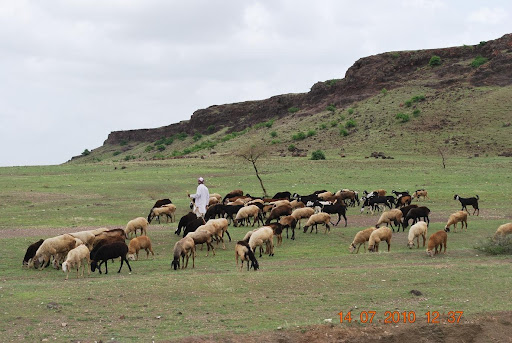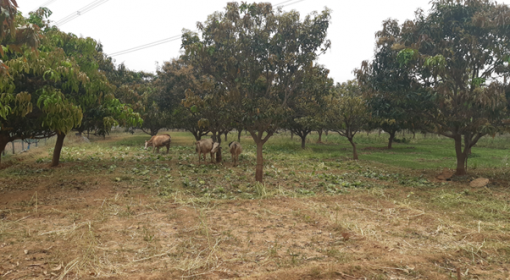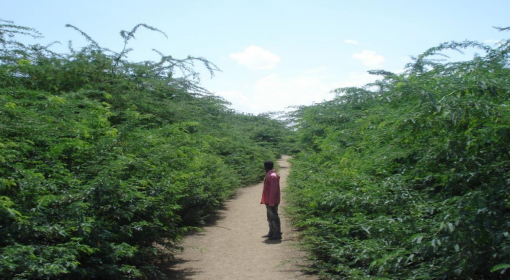By Kamal Kishore (Rainfed Livestock Network) and Bhavana Kuchimanchi (The Foundation for Ecological Security)

Livestock production in India is often misunderstood. The dominant narrative brands India’s livestock production as a low-output system which is inefficient and emits high methane. The native breeds are also considered low-producing animals as efficiency is often measured by output per individual animal.
If this is the case, it is quite perplexing how India is the largest exporter of sheep and goat meat ( i.e, exported 8,695.97 MT of sheep and goat meat worth 60.04 USD (in millions) APEDA, 2021-22). It is also the world’s largest milk producer ( FAO, 2022). Besides, India contributes 43% of the world’s buffalo meat production (APEDA, 2021) as well. Along with livestock, India also exports large quantities of grain for intensive livestock keeping, including maize and oil meal cakes (GoI, Agricultural Statistics, 2021). Another layer of bewilderment is that all this is produced in a country with 69% dryland (UNFCCD, 2010), rapidly increasing water stress conditions, growing competition for land resources, and, last but not least, India’s growing population.
This level of production is not from the sheer numbers of livestock population in the country but its more to do with how animal source foods are produced. The most dominant system of production in India is “agropastoral.” Additionally, approximately 6% of India’s population is estimated to be nomadic pastoral populations (DFID, 2016; Kullu Call, 2016) which are a lifeline to India’s agricultural production.
Both systems are embedded in complex wide-ranging social arrangements within the community, with crop farmers, other local communities in allied sectors, and traders. For feed, a mosaic of grazing resources producing more than 70% of meat and 50% of milk in India ( (Kullu Call,2016). The feed resources include common property resources, crop fallows, and forests – which approximately accounts for 60% of the feed requirements. The remaining 40% is met from crop residues and cultivated fodder. This form of feed availability is evident from the fact that of the total cultivated land, only 4-5% of arable land is used for fodder production. Furthermore, India’s livestock is not industrialized except for the commercial poultry sector and ,therefore, does not depend on grain.
Compared to western intensive systems, Indian agropastoral and pastoral systems are extensive. What’s unique in these systems is that the animals utilize any available biomass to produce high value animal protein – while providing de-weeding, germination, and fertilizing services. These features keep the input costs for production almost low to negligible due the inbuilt circularity. Further, as less land is used for feed cultivation, the water used to produce livestock products is limited to just crop residue production. These systems are also highly flexible and can cope with fluctuations in feed supply. This is because the livestock walks to the feed resources. These systems, therefore, are low-carbon systems with minimal maintenance costs. Lastly, the most striking feature of these systems is that they are driven by the animal, herd intelligence, and years of accumulated traditional knowledge of the livestock keepers and pastoralists – all of which is often unrecognized.
These facets of production make these systems most advantageous to small and marginal farmers, who are a majority in India. They also safeguard the long-term resilience of small-holders as it causes minimal biodiversity loss; are climate change mitigating (Naidu et al, 2022); does not interfere with the nitrogen or phosphorus cycle, along with several other conservation benefits (PASTRES, 2022). What’s more agropastoral and pastoral systems are already aligned to natural farming principles as they are chemical-free, soundly grounded in agroecology, and have a diversified system of farming that allows optimal use of functional biodiversity.
Hence, it is imperative to think of ways to safeguard extensive systems, as development always doesn’t mean introducing something new or intensifying agriculture. The answer lies in documenting and valuing the extensive systems, as they are in tune with planetary boundaries, use what nature provides, and have a long history of evolution. The criticality lies in investing and protecting the CPRs that are the basis of India’s livestock production. Extensive systems if safeguarded have the ability to limit land use change, and secure ground water resources. We urge the need to stop looking at livestock and crops in isolation or promoting the specialization of farming systems and take a systemic perspective instead. The rationale is to make the optimal use of available biomass rather than maximizing output per individual animal.
This approach is not limited to India but across the dryland regions of the world!
References :
APEDA, 2021-22. https://apeda.gov.in/apedawebsite/SubHead_Products/Sheep_Goat_Meat.htm
DFID,2016- https://assets.publishing.service.gov.uk/media/57a08ce2e5274a31e00014fa/ZC0181b.pdf
FAO, 2022 , accessed 7th December 7, 2022 .https://www.fao.org/dairy-production-products/production/en/#:~:text=India%20is%20the%20world’s%20largest,growth%20in%20the%20developing%20world.
Kullu call, 2016. http://rln.org.in/wp-content/uploads/2019/04/Kullu-Call-Brochure.pdf
Naidu, D. G. T, Roy, S. Bagchi, S. Loss of grazing by large mammalian herbivores can destabilize the soil carbon pool. Proceedings of the National Academy of Sciences, 119(43), e2211317119 (2022). https://doi.org/10.1073/pnas.2211317119
PASTRIES, 2022 – https://pastres.files.wordpress.com/2022/09/en-infosheet-1of6.pdf
UNFCCD,2010. http://www.indiaenvironmentportal.org.in/files/UNCCD%20bullets.pdf



